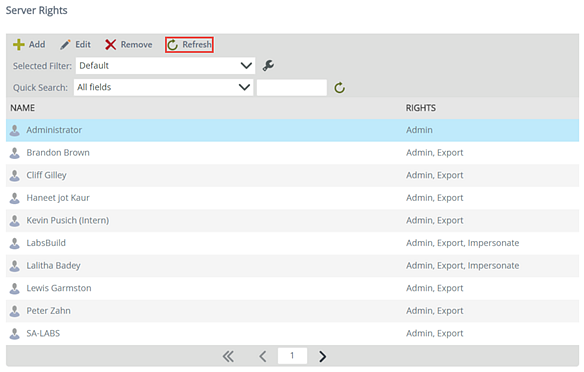Server Rights
The Server Rights node is used to add, edit, remove and refresh Workflow server permissions for users or groups. These rights will determine which users and groups can administer a K2 workflow server, export new workflows or impersonate a user. 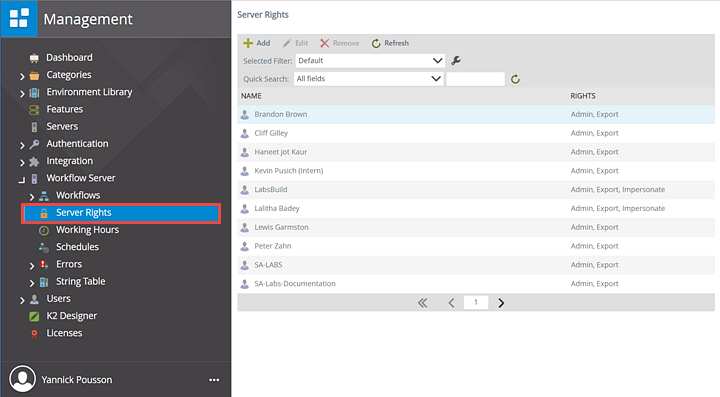
The table below explains each permission in more detail.
| Permission | Description | Usually Assigned to |
|---|---|---|
| Admin | Use the management console (and management tools in Process Portals sites) to administer a K2 environment, Users with this right can fully administer a K2 environment and may edit server rights for other users. |
|
| Export | Export/Deploy new workflow definitions to the K2 environment from K2 Studio, K2 for Visual Studio or a K2 deployment (.msbuild) package. |
|
| Impersonate |
Impersonate another user account after the initial connection to K2. This permission is normally used when user credentials cannot be transferred between machines and Kerberos cannot be used to address this requirement, and is also used for K2’s Pass-Through Authentication mechanism . It also allows for connections established in one context to impersonate another user. When the user opens a connection to the server through the client API for an example, you have a method connection ImpersonateUser(Username) which will then open the connection as the userName specified. For example John has impersonate rights. He can now open a connection and impersonate as Sue. With the connection open as Sue, he can do everything as if Sue was logged on. |
|
Follow these steps to add rights:
- Click Add from the Server Rights view.

- The Server Rights - Add Users and Groups page opens.
Use the image and table below as a guideline for the configuration:

Field Description Search Click the Search drop-down and select to search for users or groups. Label Click the Label drop-down and select the Security Provider label you want to search on. Type Click the Type drop-down and select the type of search that will be performed. Search Button Type a value in the text box provided and click the Search button. Add Button The matching users or groups will be returned in the first view. Select a user or group and click Add. The user or group will now be listed in the second view. You can add multiple users or groups by doing a new search and clicking the Add button again. Remove Button To remove users, select the user or group from the second view and click Remove. Next Button Click Next to continue with the configuration. Cancel Button Click Cancel if you no longer want to complete the configuration. This will take you back to the Rights tab. - Select the applicable rights per user or group, and click Finish.
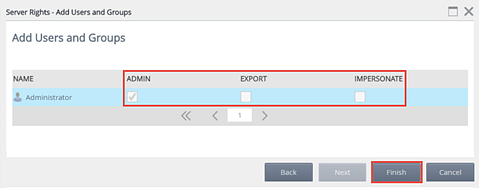
Follow these steps to edit Server Rights for users or groups:
- Select the user or group you want to edit the rights for from the Server Rights view.
- The Edit button becomes available.
- Click Edit.

- Use the check boxes to change the user or groups permissions.
- Click Finish.
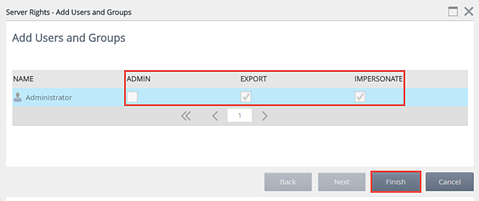
Follow these steps to remove Server Rights for users or groups:
- Select the user or group you want to remove from the Server Rights view.
- The Remove button becomes available.
- Click Remove.
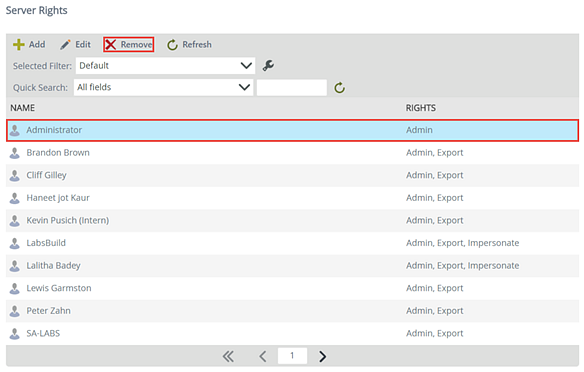
- Click OK on the confirmation message. The user or group will be removed from the Server Rights view and will no longer have the Server permissions that was assigned to them.
The Refresh button is used to refresh the list of Server Rights once changes have been applied.